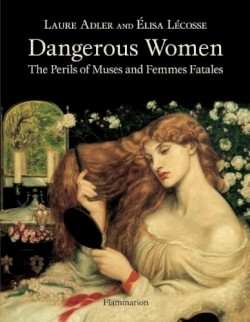
Dangerous Women
The Perils of Muses and Femmes Fatales
“History and mythology are full of female figures who made a crucial impact on cultural or political life,” the authors write.
In Dangerous Women, Adler, a journalist and feminist historian, and Lécosse, who holds a doctorate in art history and authored Love in the Louvre, analyze the women who have exerted a siren-like pull on men. More than forty-five women are included, such as sorceress Circe, the brewer of potions; irresistible Esther, the bewitching slave-girl; and infamous Pandora, “a poisoned chalice for mankind.” These character sketches are accompanied and illuminated by 100 color reproductions of memorable paintings.
“This journey through the history of art invites us to examine for ourselves the various metamorphoses of woman in love,” Adler writes in her introduction. She provides perspectives on women which include the “fascination” with virgins, “the instantaneousness of desire,” male/female relationships, and “women with the hearts of men.” The feminist historian illustrates her remarks with references to different portrayals of the Virgin Mary, like the “sexualized virgin” in The Annunciation c.1450 by Flippo Lippi, in which the artist “turns [the Virgin Mary] into a bride.”
Included in the “Seductress and Enchantress” chapter is Viviane, “the Lady of the Lake,” who beguiles from Merlin his knowledge of the arcane. In “Emancipation and Transgression in Love” a metaphor of the dangers of female power is illustrated by Ovid’s nymph Salmacis entangling Hermaphroditus. Boston eccentric Isabella Stewart Gardner appears in “Women and Power,” painted by John Singer Sargent; known as the “serpent of the Charles,” she assembled a collection of men and art. In “The ‘Eternal’ Feminine” is devotee Juliette Drouet, Victor Hugo’s inamorata; even though this actress was betrayed many times by him, she wrote more than one thousand billets-doux to Hugo.
Francesca in “Women in Love” falls for Paolo, the brother of the husband she was forced to marry. In punishment for their entangled liaison they appear in Dante’s “Second Circle,” “so painful that it stings to groan.” The description of Ary Scheffer’s The Shades of Francesca di Rimni and Paolo Malatesta Appearing to Dante and Virgil c.1855 is artfully rendered: “Their luminous, entwined bodies appear to surge up from black depths through which they float ethereally.”
The book’s strengths are its descriptions and interpretations, though Adler’s penchant for rhetorical questions can occasionally annoy. Overall, this book is a provocative marriage of words and image: the selection of illustrative paintings is admirably chosen, and Dangerous Women provides a full palette of feminine power.
Disclosure: This article is not an endorsement, but a review. The publisher of this book provided free copies of the book to have their book reviewed by a professional reviewer. No fee was paid by the publisher for this review. Foreword Reviews only recommends books that we love. Foreword Magazine, Inc. is disclosing this in accordance with the Federal Trade Commission’s 16 CFR, Part 255.
